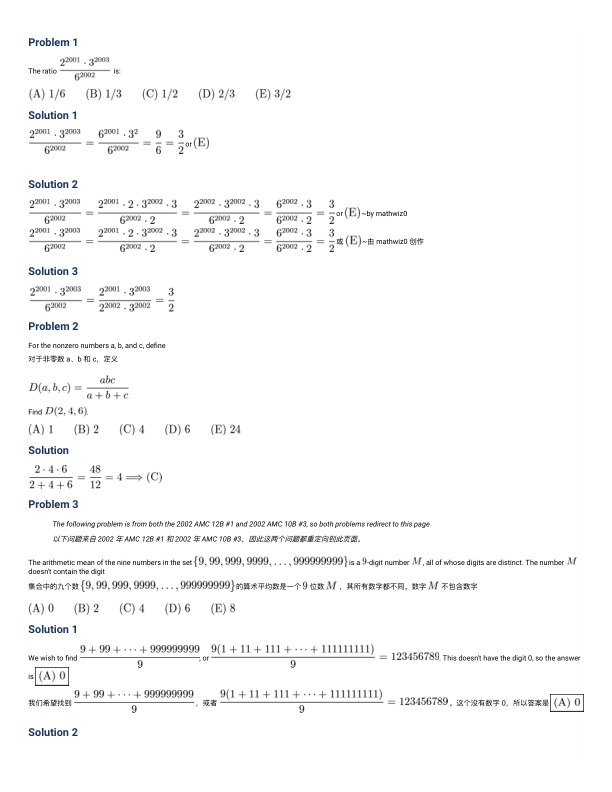2002 AMC amc10b 真题 答案 详解
| 序号 | 文件列表 | 说明 | ||
|---|---|---|---|---|
| 1 | 2002-amc10b-paper-eng.pdf | 3 页 | 176.73KB | 英文真题 |
| 2 | 2002-amc10b-key.pdf | 1 页 | 10.11KB | 真题答案 |
| 3 | 2002-amc10b-solution-eng.pdf | 15 页 | 1013.20KB | 真题文字详解(英文) |
| 4 | 2002-amc10b-solution-eng-zh.pdf | 21 页 | 1.14MB | 真题文字详解(中英双语) |
英文真题
2002 AMC 10B Problems
Problem 1
The ratio (\frac{2^{2001} \cdot 3^{2003}}{6^{2002}}) is:
(A) (\frac{1}{6}) (B) (\frac{1}{3}) (C) (\frac{1}{2}) (D) (\frac{2}{3}) (E) (\frac{3}{2})
Problem 2
For the nonzero numbers (a), (b), and (c), define
[
(a, b, c) = \frac{abc}{a + b + c}
]
Find ((2, 4, 6)).
(A) 1 (B) 2 (C) 4 (D) 6 (E) 24
Problem 3
The arithmetic mean of the nine numbers in the set ({9, 99, 999, 9999, \ldots, 999999999}) is a 9-digit number (M), all of whose digits are distinct. The number (M) does not contain the digit
(A) 0 (B) 2 (C) 4 (D) 6 (E) 8
Problem 4
What is the value of
[
(3x - 2)(4x + 1) - (3x - 2)4x + 1
]
when (x = 4?)
(A) 0 (B) 1 (C) 10 (D) 11 (E) 12
Problem 5
Circles of radius 2 and 3 are externally tangent and are circumscribed by a third circle, as shown in the figure. Find the area of the shaded region.
(A) (3\pi) (B) (4\pi) (C) (6\pi) (D) (9\pi) (E) (12\pi)
Problem 6
For how many positive integers (n) is (n^2 - 3n + 2) a prime number?

真题文字详解(英文)
Problem 1 The ratio ( \frac{2^{2001} \cdot 3^{2003}}{6^{2002}} ) is:
(A) ( \frac{1}{6} ) (B) ( \frac{1}{3} ) (C) ( \frac{1}{2} ) (D) ( \frac{2}{3} ) (E) ( \frac{3}{2} )
Solution 1
( \frac{2^{2001} \cdot 3^{2003}}{6^{2002}} = \frac{6^{2001} \cdot 3^2}{6^{2002}} = \frac{9}{6} = \frac{3}{2} ) or (E)
Solution 2
( \frac{2^{2001} \cdot 3^{2003}}{6^{2002}} = \frac{2^{2001} \cdot 2 \cdot 3^{2002} \cdot 3}{6^{2002} \cdot 2} = \frac{2^{2002} \cdot 3^{2002} \cdot 3}{6^{2002} \cdot 2} = \frac{6^{2002} \cdot 3}{6^{2002} \cdot 2} = \frac{3}{2} ) or (E) ~by mathwiz0
Solution 3
( \frac{2^{2001} \cdot 3^{2003}}{6^{2002}} = \frac{2^{2001} \cdot 3^{2003}}{2^{2002} \cdot 3^{2002}} = \frac{3}{2} )
Problem 2 For the nonzero numbers a, b, and c, define
( D(a, b, c) = \frac{abc}{a + b + c} )
Find ( D(2, 4, 6). )
(A) 1 (B) 2 (C) 4 (D) 6 (E) 24
Solution
( \frac{2 \cdot 4 \cdot 6}{2 + 4 + 6} = \frac{48}{12} = 4 \Rightarrow \text{(C)} )
Problem 3 The following problem is from both the 2002 AMC 12B #1 and 2002 AMC 10B #3, so both problems redirect to this page.
The arithmetic mean of the nine numbers in the set {9, 99, 999, 9999, ..., 999999999} is a 9-digit number M, all of whose digits are distinct. The number M doesn't contain the digit
(A) 0 (B) 2 (C) 4 (D) 6 (E) 8
Solution 1
We wish to find
( \frac{9 + 99 + \cdots + 999999999}{9}, \text{or } \frac{9(1 + 11 + 111 + \cdots + 111111111)}{9} = 123456789. ) This doesn't have the digit 0, so the answer is
(\boxed{\text{(A) 0}})
Solution 2
Notice that the final number is guaranteed to have the digits {1, 3, 5, 7, 9} and that each of these digits can be paired with an even number adding up to 9. (A) 0 can be taken out, with the other digits fulfilling divisibility by 9.
(\boxed{\text{(A) 0}})
Solution 3
The arithmetic mean is
( \frac{(10^1 - 1) + (10^2 - 1) + \cdots + (10^9 - 1)}{9} = \frac{1111111101}{9} = 123456789. ) So select
(\boxed{\text{A}}) ~hastapasta
Problem 4 The following problem is from both the 2002 AMC 12B #2 and 2002 AMC 10B #4, so both problems redirect to this page.
What is the value of ( (3x - 2)(4x + 1) - (3x - 2)4x + 1 ) when ( x = 4? )

真题文字详解(中英双语)
Problem 1
The ratio ( \frac{2^{2001} \cdot 3^{2003}}{6^{2002}} ) is:
(A) ( \frac{1}{6} ) (B) ( \frac{1}{3} ) (C) ( \frac{1}{2} ) (D) ( \frac{2}{3} ) (E) ( \frac{3}{2} )
Solution 1
( \frac{2^{2001} \cdot 3^{2003}}{6^{2002}} = \frac{6^{2001} \cdot 3^2}{6^{2002}} = \frac{9}{6} = \frac{3}{2} ) or (E)
Solution 2
( \frac{2^{2001} \cdot 3^{2003}}{6^{2002}} = \frac{2^{2001} \cdot 2 \cdot 3^{2002} \cdot 3}{6^{2002} \cdot 2} = \frac{2^{2002} \cdot 3^{2002} \cdot 3}{6^{2002} \cdot 2} = \frac{6^{2002} \cdot 3}{6^{2002} \cdot 2} = \frac{3}{2} ) or (E) ~by mathwiz0
Solution 3
( \frac{2^{2001} \cdot 3^{2003}}{6^{2002}} = \frac{2^{2001} \cdot 3^{2003}}{2^{2002} \cdot 3^{2002}} = \frac{3}{2} )
Problem 2
For the nonzero numbers a, b, and c, define
( D(a, b, c) = \frac{abc}{a + b + c} )
Find ( D(2, 4, 6). )
(A) 1 (B) 2 (C) 4 (D) 6 (E) 24
Solution
( \frac{2 \cdot 4 \cdot 6}{2 + 4 + 6} = \frac{48}{12} = 4 \Rightarrow (C) )
Problem 3
The following problem is from both the 2002 AMC 12B #1 and 2002 AMC 10B #3, so both problems redirect to this page.
The arithmetic mean of the nine numbers in the set {9, 99, 999, 9999, ..., 999999999} is a 9-digit number M, all of whose digits are distinct. The number M doesn't contain the digit 0.
集合中的九数 {9, 99, 999, 9999, ..., 999999999} 的算术平均数是一个9位数M,其所有数字都不相同。数字M不包含数字0。
(A) 0 (B) 2 (C) 4 (D) 6 (E) 8
Solution 1
We wish to find ( \frac{9 + 99 + \cdots + 999999999}{9}, \text{or} \frac{9(1 + 11 + 111 + \cdots + 111111111)}{9} = 123456789 ). This doesn't have the digit 0, so the answer is (A) 0
我们希望找到 ( \frac{9 + 99 + \cdots + 999999999}{9}, \text{或} \frac{9(1 + 11 + 111 + \cdots + 111111111)}{9} = 123456789 )。这个没有数字0,所以答案是 (A) 0
Solution 2

